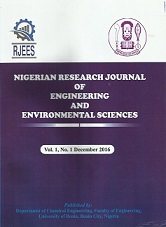PHYTOREMEDIATION OF CRUDE OIL POLLUTED SOIL USING GLYCINE MAX AND MEGATHYRSUS MAXIMUS
Authors: *Egharevba I.P, Aluyor E.O, Osagiede C.A, Ihoeghian N.A
DOI Info: N/A
ABSTRACT
The potential of Glycine max (soybean) and Megathyrsus maximus (guinea grass) for the purpose of phytoremediation of crude oil polluted soil was investigated in this paper. This was done by examining three soil samples labelled A, B and C for a period of eight weeks. Sample A contained crude oil, Sample B contained crude oil, G.max and cow dung, and Sample C contained crude oil, M. maximus and cow dung. The pH of samples A, B and C increased from 5.44 to 6.27, 6.95 and 7.01 respectively. The total hydrocarbon content for samples A, B and C reduced by 14.33%, 45.89% and 60.80% respectively. The total nitrogen content of samples A increased from 0.156% to 0.169%, however, for samples B and C, it decreased to 0.136% and 0.128% respectively. The total organic carbon content for samples A, B and C decreased from 4.22% to 3.45%, 2.01% and 2.11% respectively. The potassium content for samples A, B and C increased from 0.30ppm to 0.36ppm, 0.79ppm and 0.84ppm respectively. The phosphorus content in samples A, B and C reduced by 41.87%, 58.45% and 59.65% respectively. These results show that G. max is more effective in remediating crude oil polluted soil compared to M. maximus.
Affiliations: Department of Chemical Engineering, Faculty of Engineering, University of Benin, Benin City, Nigeria
Keywords: Phytoremediation, Crude Oil, Soil, Soybean, Guinea Grass
Published date: 2017/12/29









